This travel guide will help you discover the rich cultural heritage and majestic natural beauty of the newly merged Tuyen Quang – Ha Giang province in Northeastern Vietnam, officially unified in early 2025. Once two neighboring provinces, they have now merged into one vast mountainous region stretching from the peaceful Lo River valley to the iconic Ha Giang plateau. This unique destination offers a wonderful combination of lush river landscapes, primeval forests, limestone peaks over 2,000m high and unique ethnic traditions.
General Information
As one of the most beautiful and culturally rich regions in Northern Vietnam, Tuyen Quang – Ha Giang is home to dozens of ethnic minority communities, including the Kinh, Tay, Dao, Nung and H’Mong. This region spans mountains, river basins, agricultural valleys and remote villages, offering visitors peaceful natural landscapes and challenging adventures.
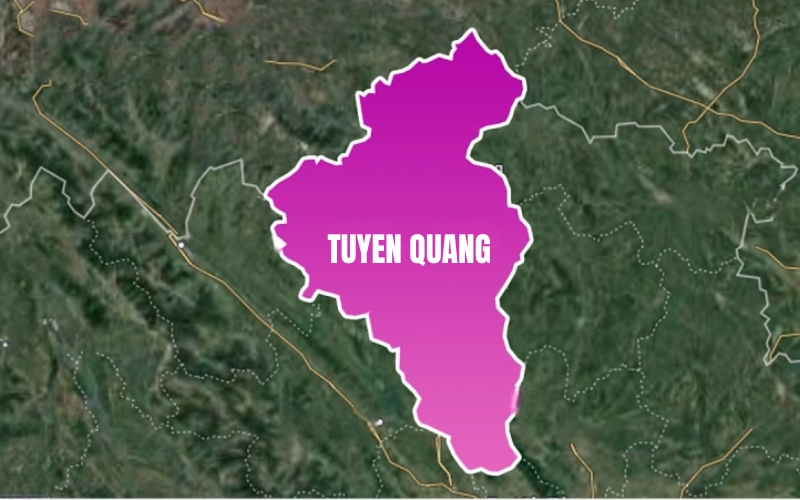
Tuyen Quang after merged
Tuyen Quang is also known as the “capital of revolution”. Tan Trao and Son Duong were historically the sites of historical events and meetings during the war. Today, visitors can explore a network of 519 historical and cultural relics, including ancient temples, battlefields and national monuments, telling the story of Vietnam’s resistance and resilience.
Tuyen Quang is not only closely associated with the country’s formation but also with the tangible and intangible cultural heritage of the ethnic communities that have long lived on this land. With its rich culture, history and landscapes, the Tuyen Quang – Ha Giang region offers a vivid and authentic experience for those who want to discover new things
Weather in Tuyen Quang & Best Time to Visit
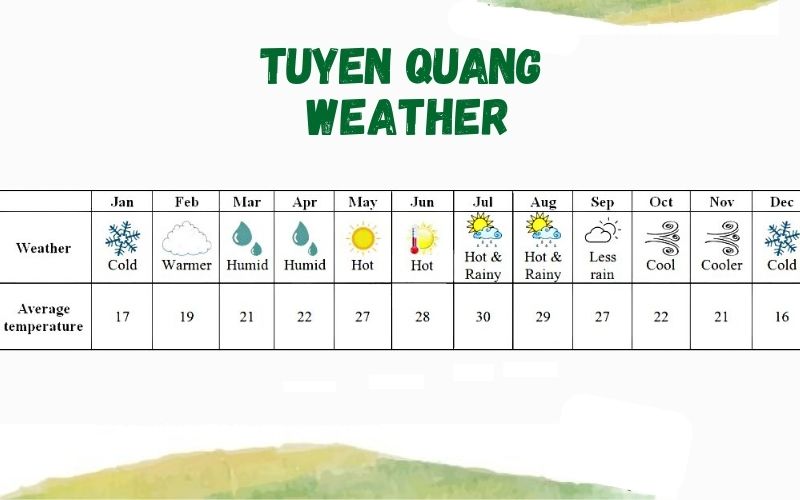
Weather in Tuyen Quang & Best Time to Visit
Located just 135 km from Hanoi in northern Vietnam, Tuyen Quang has a tropical monsoon climate strongly influenced by North Asia. Tuyen Quang has an average annual rainfall of 1,500 – 2,300 mm, with an average humidity of 82%. The annual temperature is quite cool, ranging from 22°C to 25°C. The highest temperature in summer can reach 35°C, while the lowest temperature in winter can drop to around 8°C. The coldest months are usually December and January, often accompanied by early morning frost. Thanks to its diverse terrain, Tuyen Quang has two distinct climate zones, creating excellent conditions for diverse agricultural production and year-round tourism.
- In the south and center of Tuyen Quang, the weather is generally warm and humid, with average temperatures ranging from 22°C to 27°C. Spring (February to April) brings blooming flowers and pleasant breezes, while autumn (September to November) brings clear skies and cooler air – ideal for sightseeing and cultural festivals.
- Further north, in the old Ha Giang region, the terrain becomes hilly and the climate becomes more temperate. Here, winter (December to January) can be quite cold, especially in places like Dong Van and Meo Vac, where temperatures can drop below 10°C. In contrast, the summer months (May to August) are warmer and greener, although there is occasional rain, which is short-lived.
The best time to visit Tuyen Quang is from September to November or March to May. These periods have mild weather and light sunshine, golden terraced fields in the north and are ideal conditions for outdoor activities such as exploring both historical sites, ethnic markets of Ha Giang, motorbike trips through mountain passes or boat trips along Nho Que River, the weather during these months will make your experience more memorable.
Getting to Tuyen Quang
Although there is no airport, Tuyen Quang is very easy to get to by road, with a convenient transport infrastructure including highways and inter-provincial roads. From Hanoi, you can travel by bus or private car (about 4-5 hours) to the city center. If you want to go deeper into the northern mountainous regions such as Dong Van, Meo Vac, you will need to travel longer. A popular means of transport for all visitors is motorbike. Drivers will accompany you throughout the trip, crossing the most beautiful mountain passes in northern Vietnam while admiring the majestic mountain scenery.
For visitors from other provinces in the Northeast or Northwest, it is also possible to transfer to Thai Nguyen, Bac Kan or Lao Cai. Although there is no airport in the province, the nearest major airport is Noi Bai International Airport in Hanoi, which serves as the main hub for both domestic and international visitors to this newly expanded northern region.
What to See in Tuyen Quang
Historical Relic of Tan Trao
Tan Trao, which served as Vietnam’s revolutionary base prior to August 1945, is the most well-known destination on a Vietnam discovery trip, not only for its historical significance but also for its beautiful natural landscape.
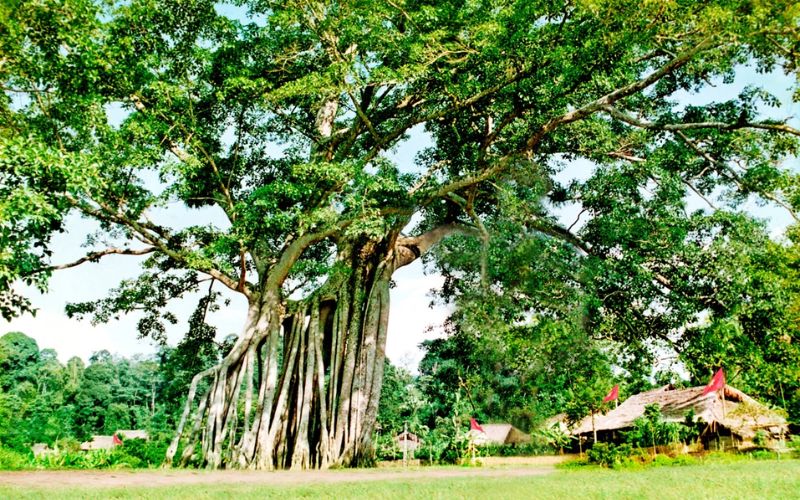
Historical Relic of Tan Trao
Tan Trao is a small valley located in Son Duong district, 41 kilometers from the center of Tuyen Quang town, where the Communist Party of Vietnam held a national party conference on August 13, 1945, to discuss the plan for a general uprising.
When coming here, visitors can have the chance to visit some remaining historical sites: Tan Trao Communal House, Hong Thai Communal House, and Tan Trao banyan tree. Tan Trao also has many caves, rich resources, and beautiful scenery that can captivate visitors at first glance.
Na Hang Ecotourism Area
There are a few destinations in Northern Vietnam that can meet the expectations of adventurous travelers who want to explore and discover mysterious caves and primeval forests, such as Na Hang. This area is located in the northern part of Tuyen Quang, 110 kilometers from the city center. Each cave, stream, and waterfall has its own legendary story, some of which have been incorporated into poetry and songs.
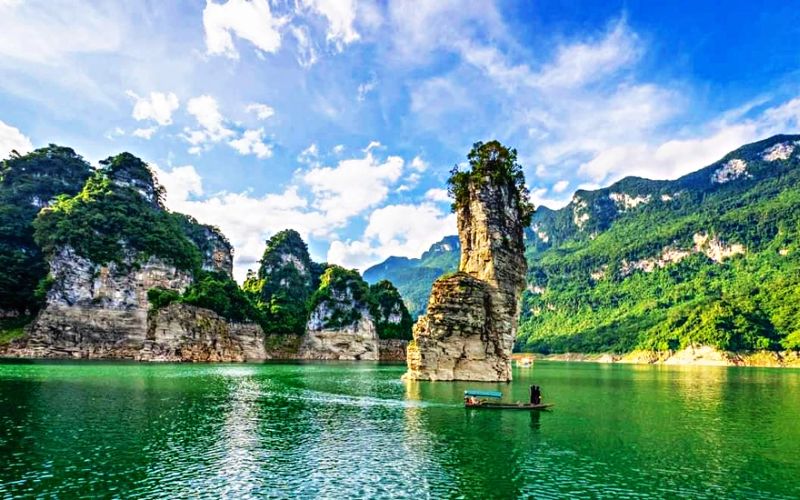
Na Hang Ecotourism Area
This is the confluence of the Gam and Nang rivers, adjacent to Ba Be Lake and surrounded by majestic mountains and inspiring land. You can also rent a small boat and travel around to see the Pac Ta and Pac Vang temples, as well as Pac Ta Mountain, which is the highest point in Na Hang.
Additionally, Tat Ke-Ban Bung Nature Reserve is the homeland of a thousand kinds of fauna and flora across 42,000ha. The term “electronic commerce” refers to the sale of goods and services over the Internet.
Moreover, Na Hang is very rich in ethnic culture with the residents of many ethnic minority groups such as Dao, Tay, Nung, and San Diu. Tourists can take cultural tours to learn about ethnic groups because of the house on stilts covered in palm leaves and specific traditional cultural features.
My Lam Mineral Stream
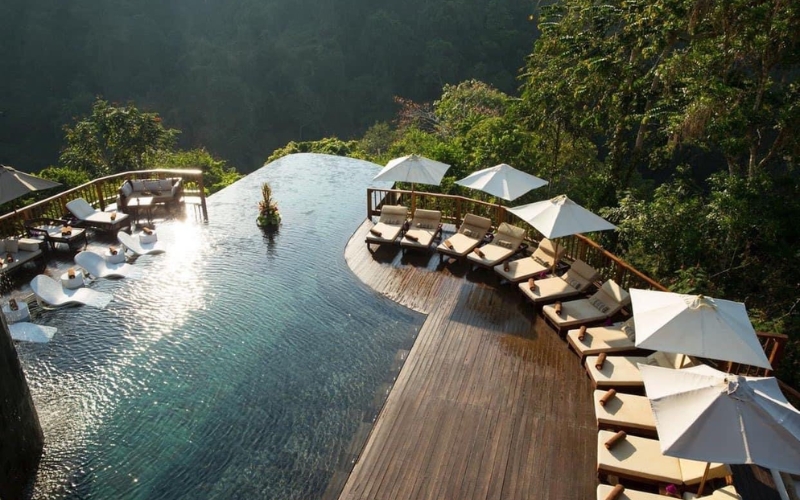
My Lam Mineral Stream
This well-known stream is located in Yen Son district, Tuyen Quang province, 13 kilometers south of Tuyen Quang’s central town. My Lam Mineral Stream entices visitors with mineral mud baths, hot mineral water baths, and breathtaking natural beauty.
The stream has sulfur mineral water underground, which was discovered in the 60s. Until now, water has been shown to contain high levels of bicarbonate, calcium, sodium, and potassium. Taking a bath in 40-42oC water helps visitors relieve stress and pressure while also restoring relaxation and pleasure. This method, too, can relieve arthritis pain and neuralgia, bringing joy and health to many patients. Aside from tangible values, local people take great pride in their intangible values, which have existed for hundreds of years.
Dong Van Karst Plateau Geopark
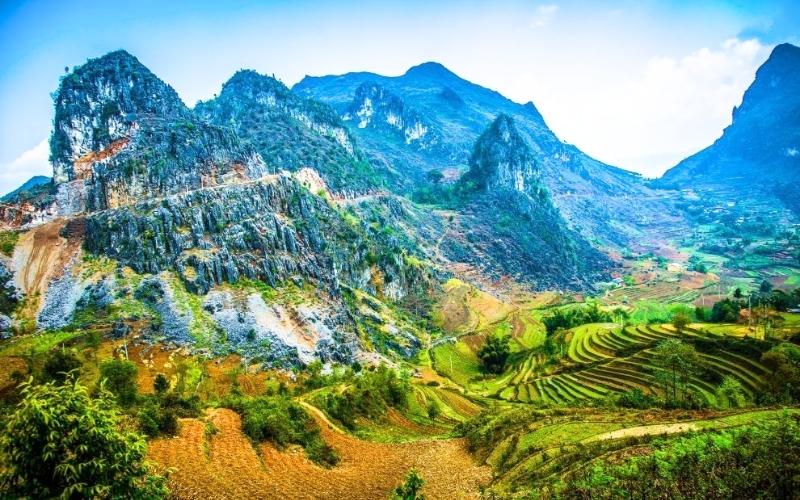
Dong Van Global Karst Plateau Geopark
This is a rugged rocky area with a gray cat-ear shape, looking very mysteriously stacked on top of each other. The limestone mountains here have an average height of more than 1000m above sea level. If you stand on a high mountain peak and look far away, you will see a vast area of undulating hills, one after another, creating a beautiful natural picture. The rocky mountains seem to be arranged into solid fences embracing the small houses of the local people and the buckwheat flower fields, all blending together to create a natural picture full of vitality and charm.
Ma Pi Leng Pass
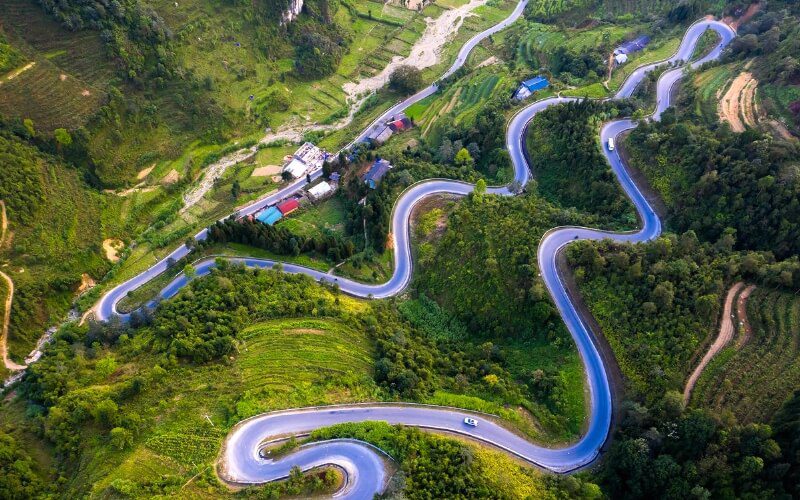
Ma Pi Leng Pass
This is one of the “four great mountain passes” with a beauty that is both wild and rugged but strangely charming and attractive. Ma Pi Leng is difficult to conquer. Therefore, it makes people crave even more to be able to overcome all the winding, winding roads surrounded by high, steep cat-ear mountains and deep ravines. But you will be able to see the green Nho Que River winding from above. On the way to the top of Ma Pi Leng, there will also be terraced fields in the ripe rice season that will turn golden, spreading across a vast area of the Northeast mountains.
Hoang Su Phi terraced fields
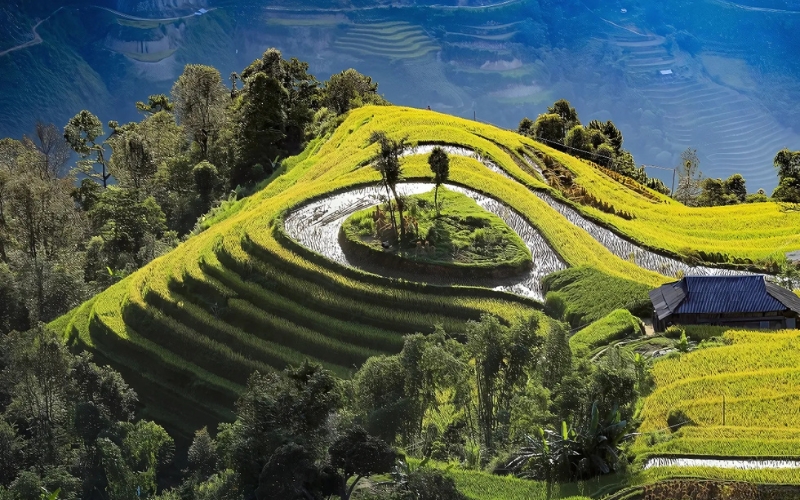
Sunlight over the rice terraces of Hoang Su Phi
The entire Hoang Su Phi terraced field heritage has about 3,000 hectares of terraced fields spread over the hillsides of 6 communes, of which the 3 most beautiful and famous villages are Nam Ty, Luoc and Phung. Admiring the fields in layers, overlapping, softly curving like a watercolor painting will definitely bring you an extremely interesting experience.
Du Gia Village & Nature Reserve
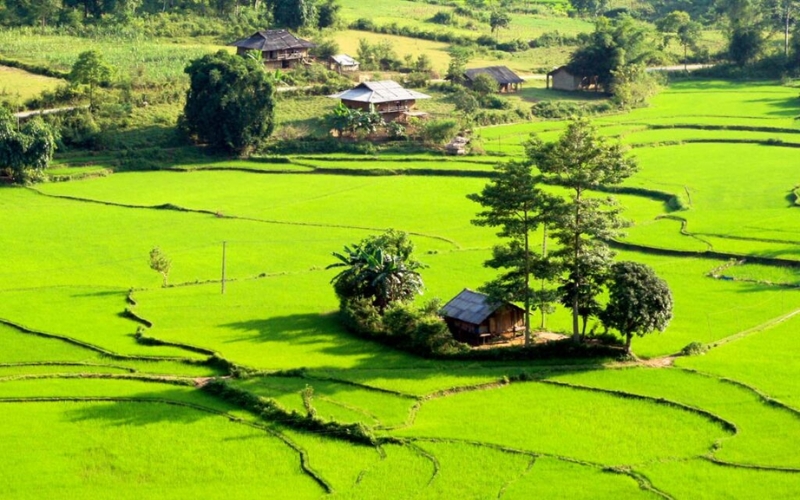
Du Gia Village
Du Gia is famous for its wild and majestic natural landscape of mountains, rivers, clouds and sky, but it is also no less poetic, making anyone who comes here fall in love with the beauty like a fairyland. Coming to Du Gia Ha Giang, you will have the opportunity to take in the whole view of the blue sky, white clouds floating on the mountain tops and small villages in the distance, the golden terraced fields and the white Tham Luong waterfall where the locals often come to bathe. The scenery here is always full of vitality, from the villages, mountains and forests to the clouds and sky, all blend together to create a fascinating attraction.
Traditional Festivals
Long Tong festival (Tay ethnic people)
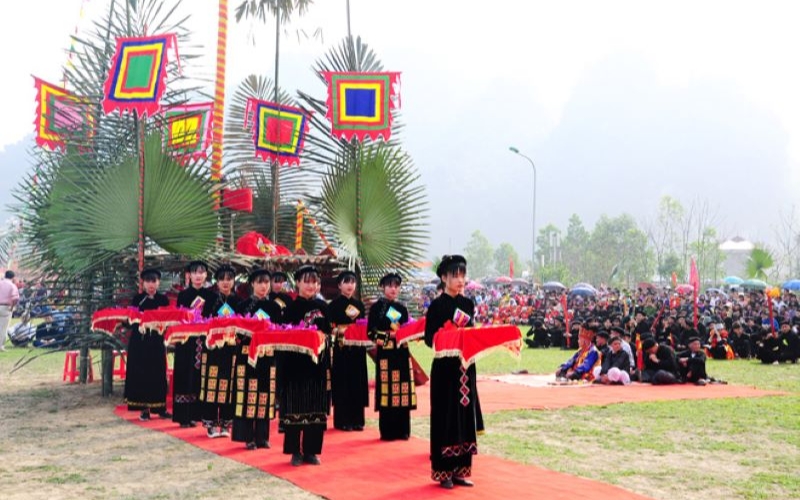
Long Tong Festival
Long Tong festival, which translates as “crop praying festival,” is an important event to kick off the new year. It is always held on the 8th lunar January with the meaning of praying for good weather conditions and productive harvests. The beauty of the villages hidden in the foothills and covered in mists will undoubtedly provide visitors with an unforgettable experience.
Mid-Autumn Festival
The festival takes place every year on Mid-Autumn occasions. This is one of the most important festivals on your trip to Vietnam. The festival includes interesting activities such as organizing the Mid-Autumn Festival for children, introducing Tuyen Quang province to visitors, and modeling dresses and costumes related to Vietnamese Mother Goddess worship.
At the festival, there will be a lantern-making contest, a fruit tray decoration contest, and music shows. Moreover, the sparkling gaudy colors from the giant lantern, in particular, will catch the attention of both local and international participants, particularly many children for the first time and leave them in a beautiful phase of their lives.
Buckwheat Flower Festival
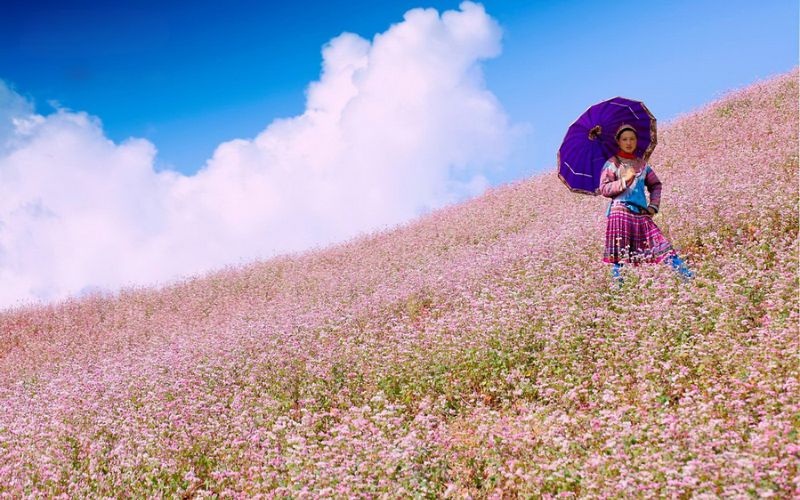
Buckwheat flower in Ha Giang
Ha Giang Buckwheat Flower Festival is the biggest flower festival of the year here, held annually on the rocky plateau. The purpose of this festival is to honor the beauty of the typical flowers of this land and spread the beautiful culture of the Mong ethnic group to all visitors across the country. Visitors will be immersed in the exciting atmosphere with artistic activities, explore traditional cuisine and participate in interesting folk games. This is a great opportunity to admire the endless purple-pink flower fields, feel the intersection between nature and culture.
What to Eat in Tuyen Quang
Tuyen Quang is famous for its diverse cuisine. There are some food specialties that can leave an indelible impression on your mind.
Black pork
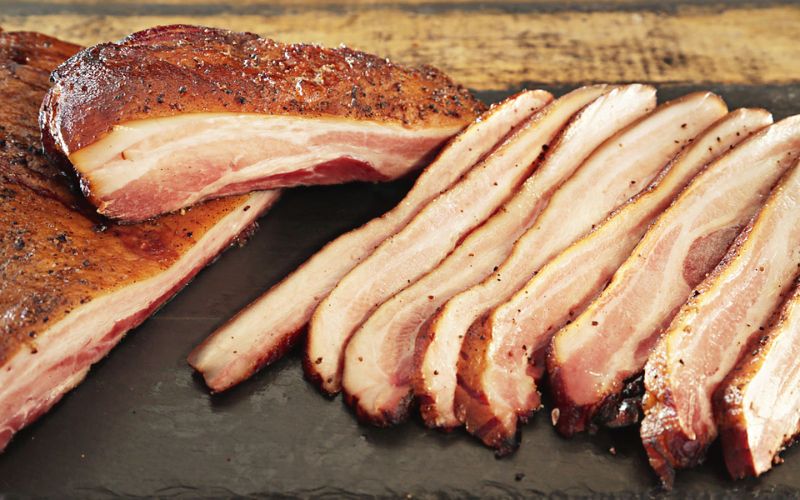
Smoked black pork
In Na Hang, a district of Tuyen Quang, this is a popular dish among ethnic minorities. The black pork is firm and delicious. Because, unlike regular pigs, the black pig is raised by natural grazing without being confined.
Steamed rice rolls
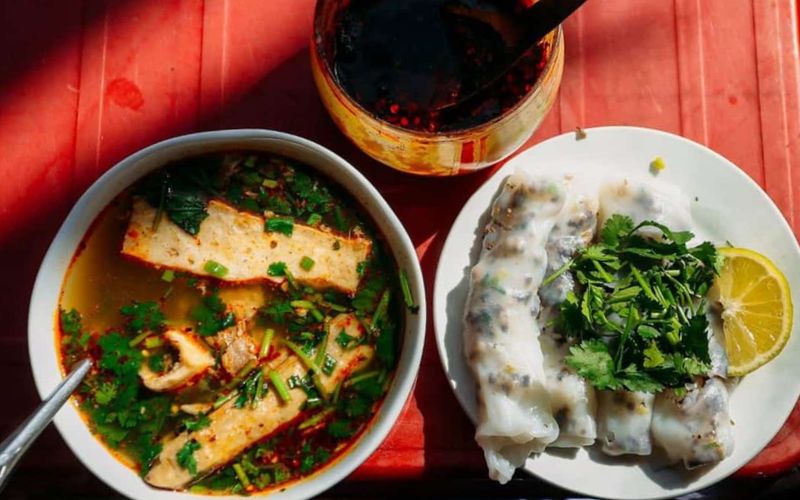
Steamed rice rolls
In contrast to other places, the crust to make steamed rice rolls in Tuyen Quang contains ingredients from three different types of rice. People soak them overnight before being milled and coated right before customers eat them, maintaining the crust’s softness, but keeping it still tough and thin. Regarding the filling, a few spices are also added to make the taste more alluring and unusual in addition to wood ear, shiitake mushrooms, meat, or shrimp paste.
Five-color sticky rice
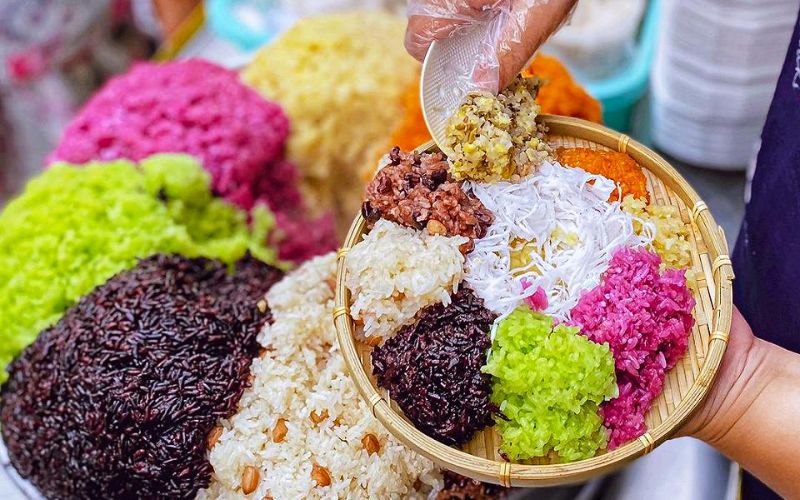
Colorful sticky rice
The multi-colors of this food are the specialty, and they are very eye-catching. You can find this food during Tay ethnic group worship holidays. The stream sticky is made of glutinous rice and is very fragrant, with five colors representing Metal, Wood, Water, Fire, and Earth: white, yellow, blue, red, and purple. There is another explanation for the colors soil, water, clouds, rain, and sunshine. Tay’s vegetable garden provided all of the ingredients for this dish.
Sticky rice with ant eggs
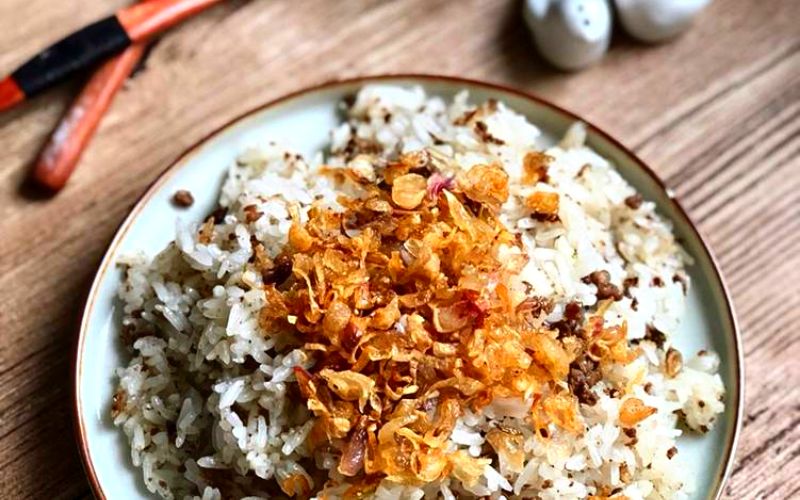
Sticky rice with ant eggs
This rustic food may sound strange to some, but if you try it once, you will definitely want to have a second bite because of the delicious taste of the sticky rice and the fat of the ant eggs mixed with onions and dill.
Corn liquor in Na Hang

Corn liquor
Like other mountainous areas, Tuyen Quang has its own kind of wine. This wine is made from maize and leaves yeast, as well as 20 herbs such as forest peppers, cinnamon, and licorice, and is distilled and steeped for a long time using traditional Na Hang methods. This wine not only has the sweet taste of corn liquor, but it also aids in the treatment of certain diseases such as rheumatism.
Smoked buffalo meat
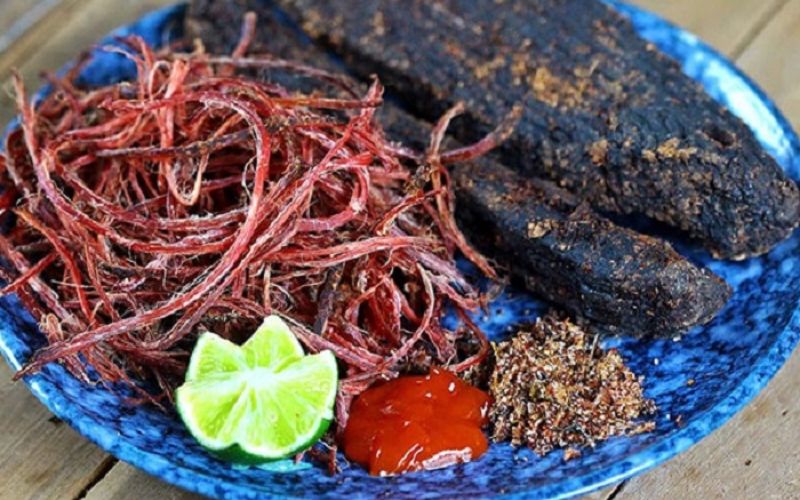
Smoked Buffalo Meat and Cham cheo
This is a traditional dish of the Black Thai people, and many crazy followers buy it as a gift on their journey to explore the rocky plateau. The dish has a spicy taste from the marinated spice mac khen, a rich sweetness from fresh buffalo meat and the smell of smoke from the kitchen that makes anyone exclaim in praise.
Thang co
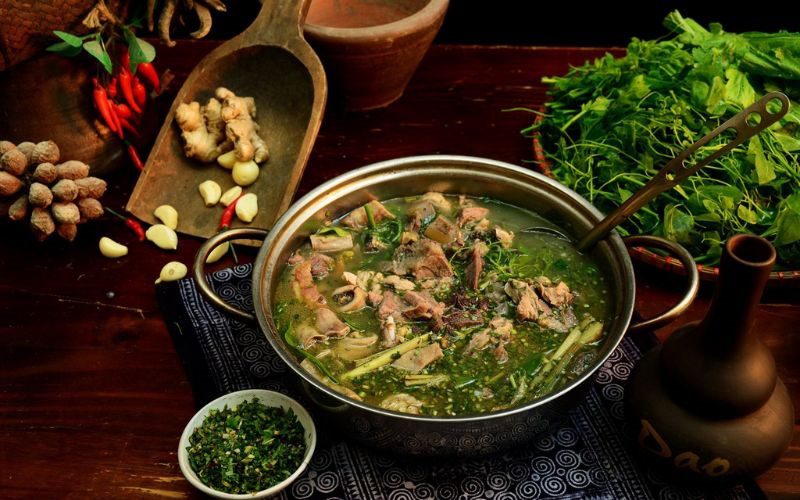
Thang Co
It can be said that this is an impressive specialty that Ha Giang people cannot stop being proud of its unique flavor. The main ingredient is usually cow’s organs, then marinated with a little spice such as dia dien, star anise, cardamom, … and simmered for about 1 hour.
Au tau porridge
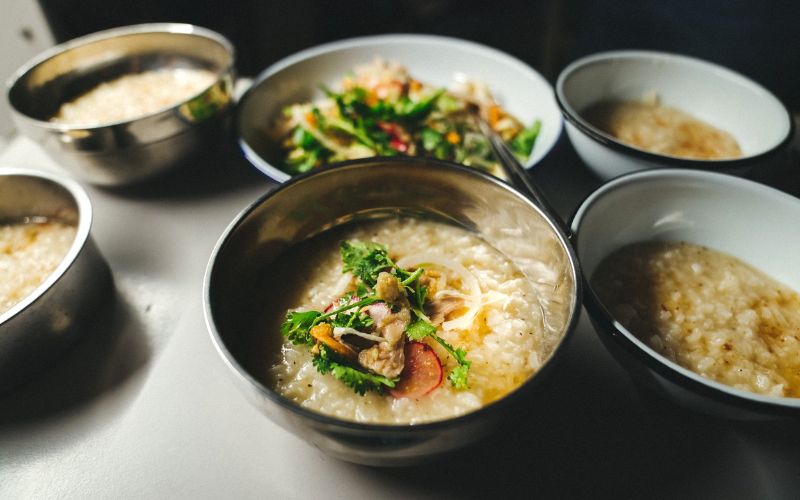
Au Tau porridge
Au tau porridge is known as the most famous specialty of the Mong people that you cannot help but try. Au tau porridge is also known as “poisonous porridge” or “deadly porridge” because it is made from au tau tubers with high levels of toxins that are only found in the Northwest region, however, if processed properly, it is a valuable medicine for health. Through the skillful hands of the Mong people, this dish has become a mountainous specialty with the typical features of the rocky plateau.
We hope this article provides you with useful information for your trip to Tuyen Quang. Contact us to find out more about this beautiful town!